All Art Lessons
SUBJECTS
GRADE
Show Results
Frrrrriction!
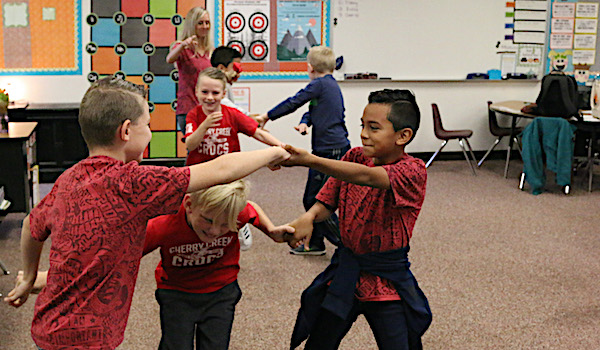
Lesson Summary
- Play the singing game “I Hear the Mill Wheel."
- Understand friction and lubrication.
- Use different timbres of instruments to create rhythmic ostinatos.
Lesson Plan and Procedure
Lesson Key Facts
- Grade(s): 3
- Subject(s): Music, Science
- Duration of lesson: Two sessions, 45 minutes each
- Author(s): Emily Soderborg
Activity 1: Mill Wheel Game Connecting to Friction and Lubrication
Sing “I Hear the Mill Wheel” while learning the game. The game and directions can be found in the “Equipment and Materials Needed” section.
Teacher: We have been singing a song about a mill wheel. Do any of you know what that is?
As a class, look at pictures of mill wheels and of gears. Have students make observations about what they notice in the pictures. Based on their observations, 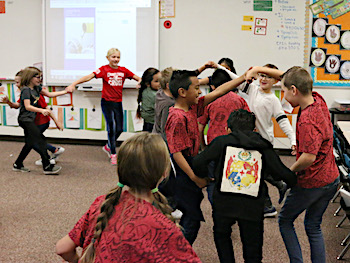 discuss how a mill wheel works using gears.
discuss how a mill wheel works using gears.
Teacher: There are many kinds of machines. A mechanical machine is powered by sources other than electricity. A mill wheel is a mechanical machine because it runs using water, which is a nonelectric source (it doesn’t plug into a wall or run on batteries). It gets its energy from the movement of water. We know the sun is the greatest source of natural heat and is the light source for our earth. However, it is not the only source of heat, light, and energy. Mechanical energy can also create heat. Mechanical heat is heat created by moving parts. This heat is caused by friction.
Teacher: Now, what is friction? Friction is caused by forces between two things when they touch, like when you drag your foot along the sidewalk and feel and hear the surfaces scuffing together. When you drag your foot on the ground, the two surfaces snag against each other. When these parts rub together, the motion makes things heat up.
Teacher: Try rubbing your hands together. Do they get warm? Now, rub them together fast and press hard. What happens? 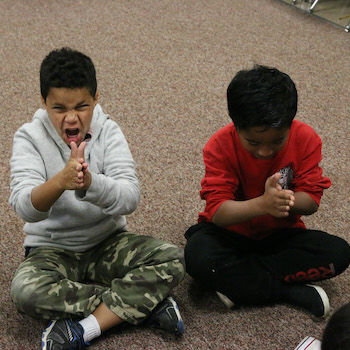 (They get even warmer.)
(They get even warmer.)
Teacher: This is an example of mechanical heat, or heat created by moving parts—in this case, our hands. Mechanical heat can be a problem. If there is too much heat, the parts of a machine may not work properly. Or the heat may make the machine dangerous to use. We can reduce friction in machines by using a lubricant—a substance that makes things slippery. Any liquid can be a lubricant, but most often, oil is used. We’re going to try using lotion as a lubricant on our hands. What do you think will happen when we rub our hands together with lotion on them? What is your hypothesis?
Listen to students’ responses and notice their reactions when they rub their hands together with lotion in between.
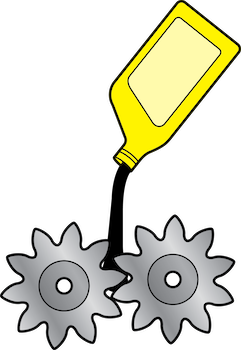 Look at the picture of gears with lubrication.
Look at the picture of gears with lubrication.
Teacher: How do you think a lubricant works? Solids are materials that have a built-in resistance to changing shape, whereas liquids can flow. Think of the difference between ice (which just sits there in a lump) and water (which flows easily as you pour it). If you put a liquid like oil between two solid gears, it will shift about and change its shape, cushioning the microscopic bumps between the gears as they mesh together. This will reduce the friction between the gears, producing easier movement.
Connect this new understanding to the “I Hear the Mill Wheel” game.
Teacher: The extra X is friction without lubricant. It creates more heat and slows down the whole turning process. Less friction means that less heat is produced and greater speed is capable. In the game, if we add enough people (lubricant) that we don’t have friction, we can see how fast we are able to move between groups on the word turning.
Play the game one more time without the extra X, and see how much the students can speed up the song and still make it understandable.
Assessment:
• Students can sing “I Hear the Mill Wheel” in tune.
• Students can explain what friction is.
• Students can connect their understanding of friction and lubrication to the game “I Hear the Mill Wheel.”
Activity 2: Friction or Lubrication Ostinatos
Note: Prepare two complete sets of vocabulary rhythm cards before starting this activity.
Teacher: Before in the activity, we played with having friction or not in our “I Hear the Mill Wheel” game. Did you prefer having friction or not having friction in the game? I think the game is more fun when we have friction.
Use questioning strategies to review the students’ knowledge of friction and lubrication as discussed in the previous activity.
Teacher: There are other times and places, besides just in this game, when we want or even need to have friction for things to work properly. Can you think of any examples of when we might need friction?
Listen to their ideas. Share the following examples, if necessary: We want friction between tires and the road, we want friction between a pencil and a piece of paper so that the lead will write on the paper, and we want friction with string instruments because the strings need the friction to create sound.
Teacher: What situations can you think of in which we would want to use lubrication? (Examples: water on water slides, oil on gears in machines, oil on bicycle chains, and so on.)
Teacher: We are going to use our voices and instruments to represent friction and lubrication. We are also going to learn about ostinatos. Ostinatos are repeated patterns in music.
Show students the picture side of the vocabulary rhythm card that reads “heat.” Invite the students to repeat the word over and over to a steady beat. Do the same for the cards that say “friction,” “temperature,” and “lubrication.”
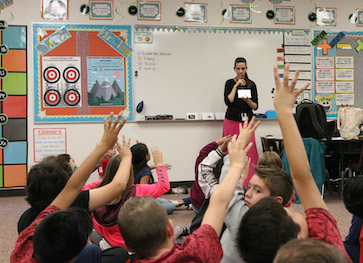 Help students discover that the word heat is one syllable and that today it will be represented as one sound in a beat. Continue by explaining that the word friction is two syllables, which will be represented as two sounds in a beat; the word temperature is three syllables, which will be represented as three sounds (two short sounds and one long sound) in a beat; and the word lubrication is four syllables, which will be represented as four sounds in a beat. As students make connections to how many syllables are in each word, turn each vocabulary card over to show the notation side of the card.
Help students discover that the word heat is one syllable and that today it will be represented as one sound in a beat. Continue by explaining that the word friction is two syllables, which will be represented as two sounds in a beat; the word temperature is three syllables, which will be represented as three sounds (two short sounds and one long sound) in a beat; and the word lubrication is four syllables, which will be represented as four sounds in a beat. As students make connections to how many syllables are in each word, turn each vocabulary card over to show the notation side of the card.
*Student Challenge: Invite students to figure out where the syllabic emphasis is on the word mechanical. They should discover that this word has four syllables, but the syllabic emphasis is on the second syllable, rather than the first. To include this word in their ostinato, the students will need to figure out how to say this word over two beats in a combination of sounds and silence, with the emphasized syllable on the first (strong) part of the second beat.
Have one student select and arrange enough vocabulary rhythm cards to create two rows of four cards. Invite the students to say the words in sequence, one word per beat. (See “Pie Rhythms” lesson plan by Jennifer Purdy for more details.)
Divide students into two groups. Give each group a complete set of vocabulary rhythm cards, each set containing four of each vocabulary rhythm card. The groups will have more cards than they will use, but this gives them the freedom to use up to four of the same vocabulary rhythm card in their ostinato.
Teacher: Each group will create an eight-beat rhythm pattern from the science vocabulary words.

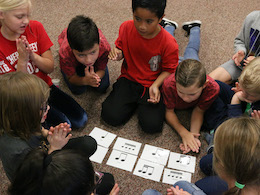
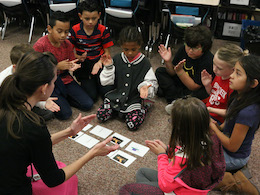
Once each group can say their rhythm pattern rhythmically and easily, introduce two timbres (pronounced “tam-bur”) of instruments: one rough-surface instrument and one smooth-surface instrument. Play a ridged wood instrument (rough surface) by sliding a mallet across its ridges, then play a smooth-surface instrument by sliding a mallet across its smooth surface. Have the students describe the sounds and then compare and contrast the sounds produced.
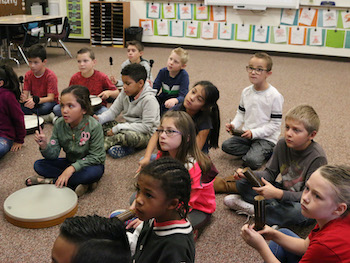 Teacher: Remember, friction is when the moving parts create force on each other. Lubrication happens when a liquid cushions the microscopic bumps between surfaces and reduces the friction. From which instrument do you hear more friction from moving parts bumping into each other? (This would be the guiro or any of the instruments with a rough surface.) So we are going to use the guiro to represent friction and the wood block to represent lubrication, which reduces friction.
Teacher: Remember, friction is when the moving parts create force on each other. Lubrication happens when a liquid cushions the microscopic bumps between surfaces and reduces the friction. From which instrument do you hear more friction from moving parts bumping into each other? (This would be the guiro or any of the instruments with a rough surface.) So we are going to use the guiro to represent friction and the wood block to represent lubrication, which reduces friction.
Pass out instruments with a rough surface to one group and instruments with a smooth surface to the other group. Have the students practice playing their eight-beat rhythm pattern on their instruments.
Sing “I Hear the Mill Wheel” all the way through as a class. The second time through the song, have the friction group (rough-surface instrument) play and say their ostinato while the lubrication group (smooth-surface instrument) sings “I Hear the Mill Wheel.” Switch roles the next time through. As time allows, divide each group in half again, and have one half of each group play while the other half of each group (half the class) sings, and then switch to allow the other students to play while those that played first sing. As a challenge, have the students play their rhythmic ostinato while singing “I Hear the Mill Wheel.”
Play the game again as time allows.

Assessment:
- Students can speak and play their rhythmic ostinato while others sing “I Hear the Mill Wheel.”
- Students can represent friction and lubrication through two different timbres.
- Students can give the definition of lubrication and name a common lubricant.
Learning Objectives
- Understand causes and uses of friction and lubrication.
- Demonstrate how heat is produced through friction.
- Play the song “I Hear the Mill Wheel,” and play the associated game.
- Use different timbres of instruments to create rhythmic ostinatos.
Utah State Board of Education Standards
This lesson can be used to meet standards in many grades and subject areas. We will highlight one grade’s standards to give an example of application.
Grade 3 Science
- Standard 5: Students will understand that the sun is the main source of heat and light for things living on Earth. They will also understand that the motion of rubbing objects together may produce heat.
- Objective 3: Demonstrate that heat may be produced when objects are rubbed against one another.
- Identify several examples of how rubbing one object against another produces heat.
- Compare relative differences in the amount of heat given off or force required to move an object over lubricated/non-lubricated surfaces and smooth/rough surfaces (e.g., waterslide with and without water, hands rubbing together with and without lotion).
- Objective 3: Demonstrate that heat may be produced when objects are rubbed against one another.
Grade 3 Music
- Standard 3.M.CR.1: Improvise rhythmic and melodic patterns and musical ideas for a specific purpose using a specific tone set and simple meters.
- Standard 3.M.P.4: Sing folk, traditional, and call-and-response songs in tune, with good vocal tone.
- Standard 3.M.P.7: Perform and identify rhythm patterns in two-, three-, and four-beat meters using body percussion, voice, and simple instruments.
- Standard 3.M.R.2: Recognize form, meter, beat versus rhythm, timbre, mood, dynamics, tempo, melody, texture and harmony/tonality.
- Standard 3.M.R.4: Describe feelings or imagery conveyed by a music selection.
- Standard 3.M.CO.1: Describe how music relates to personal, social, emotional, and intellectual development; use life experience and additional content knowledge to inspire and respond to music and deepen understanding of another content area through music.
Equipment and Materials Needed
- Open space for the game
- Lotion
- Rhythm instruments, at least one rough-surface instrument and one smooth-surface instrument (this lesson can work with only one of each type of instrument, but it is written with the idea that every student will have access to an instrument)
- Rough: Guiro, rasp, ridged rhythm sticks, sandpaper blocks, or even pool noodles cut into four-inch pieces and then cut down the center
- Smooth: Smooth wood block and mallet, smooth rhythm sticks, one cymbal with a soft mallet, or drum with soft mallet
- “I Hear The Mill Wheel” sheet music and game instructions PDF
- Two-sided science vocabulary rhythm cards (picture on one side, rhythm notation on the other) PDF
- Four heat cards
- Four friction cards
- Four temperature cards
- Four lubrication cards
- Four mechanical cards (only pictures, no notation for this set)
- Images:
- A mill wheel: https://pixabay.com/en/mill-water-mill-old-mill-wheel-1309645/
- Gears in a mill wheel: https://commons.wikimedia.org/wiki/File:Mt_Vernon_Gristmill_Gears.jpg, https://commons.wikimedia.org/wiki/File:Storckensohn_gears_and_millstone.jpg
- Gears: https://commons.wikimedia.org/wiki/File:Gears_(20437315996).jpg
- Gears being lubricated: https://www.indiamart.com/proddetail/lubricant-gear-oil-16072453712.html
Additional Resources
- Utah third-grade open education resource science textbook: https://www.uen.org/oer/
- http://www.explainthatstuff.com/lubricants.html
- http://voyageurbrigade.org/wp-content/uploads/2017/03/LJS-Lund-Ten-Voyageur-and-French-Folk-Songs.pdf
Image References
Images 1–3: James Huston.
Image 4: Curtis Soderborg.
Images 5–10: James Huston.

www.education.byu.edu/arts/lessons
 Download
Download